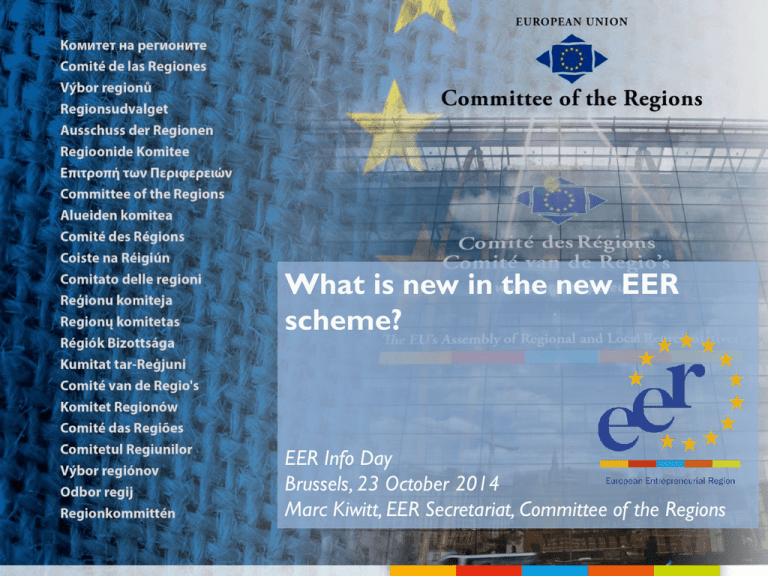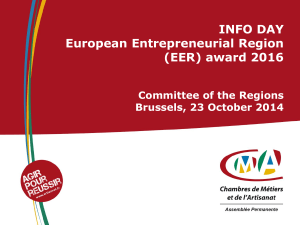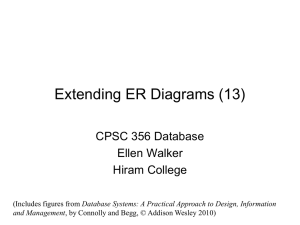Marc Kiwitt
advertisement

What is new in the new EER scheme? EER Info Day Brussels, 23 October 2014 Marc Kiwitt, EER Secretariat, Committee of the Regions 1. Key characteristics of the EER scheme 2. Main features of the 2014 EER review 3.The revised assessment criteria 1. Key characteristics of the EER scheme Main features: The EER label is an award for entrepreneurial territories that was launched by the Committee of the Regions in 2009. It is targeted exclusively at local and regional authorities. Policy strategy: The EER label rewards the most convincing forward-looking political vision aiming to make regions more entrepreneurial. Partnership approach: Creation of EER communities including all relevant stakeholders (business, academia, schools, clusters etc.) and levels of governance (local/regional/national). Principal objectives: Implementing the Small Business Act for Europe (SBA) at local and regional level. Demonstrating optimal use of EU and other public funds oriented towards the development of an entrepreneurial policy within the region. “The EER award is future-oriented: We reward those regions that have a forward-looking political vision to implement the SBA principles.” Michel Lebrun, President of the Committee of the Regions and Chair of the EER jury, at the EER 2016 launch, 1 October 2014 Methodology: EER regions for the following year are selected ex-ante on the basis of their political commitment to a forward-thinking, ambitious and sustainable action plan. During their EER year and beyond, the EER regions implement concrete measures aimed at mainstreaming the SBA principles, as well as specific communication activities. The implementation is monitored by the EER jury. After the EER year, ex-post evaluation missions verify the implementation of the action plan in the EER regions and issue policy recommendations to the regions. EER jury: Jury Chair: the CoR President Jury members: Members of the Committee of the Regions Representatives of the European Commission, the European Parliament, and the European Economic and Social Committee Economic and social partners: UEAPME, Eurochambres, Social Economy Europe EER award winning regions: Winners 2011: Land Brandenburg – Germany Kerry County – Ireland Murcia Region – Spain Winners 2012: Catalonia – Spain Helsinki-Uusimaa Region – Finland Trnava Region – Slovak Republic Winners 2013: Nord-Pas de Calais – France Southern Denmark – Denmark Styria – Austria Winners 2014: Flanders – Belgium Marche Region – Italy North Brabant – Netherlands Winners 2015: Lisbon – Portugal Northern Ireland – United Kingdom Valencian Region – Spain The EER Award does not carry any financial compensation, but... 1. The EER gives a strong political impetus to involve all relevant actors in the design and implementation of an entrepreneurial strategy within a territory. “For our region, the EER label has been the banner under which we have rallied the key players of entrepreneurship and enterprise creation." Charlotte Peytavit, Head of Unit “Creation of activities”, Regional Council of Nord-Pas de Calais (EER 2013). 2. The EER encourages regions to develop their strategy beyond their EER year and strengthens multi-level governance in the delivery of SME-friendly policies. The mayor of the town of Jumilla, Murcia Region (EER 2011), signing an “Entrepreneurial Municipality” agreement on 21 January 2014 3. The EER award is a European seal of excellence for entrepreneurship policies that the awarded regions are successfully using as a marketing tool. Northern Ireland‘s 2015 EER trophy on display at Belfast City Hall 4. With fifteen awarded regions, the EER network has reached the critical mass necessary for a productive exchange of good practices and for fruitful cooperation initiatives between EER regions. Representatives of the EER regions meeting at the occasion of the EER 2014 Open Days workshop EER 2016 edition: Launch of the 2016 edition at the SME Assembly in Naples on 1 October 2014 by CoR President Michel Lebrun. Deadline for applications: 16 March 2015. 2. Main features of the 2014 EER review The EER review: Building on lessons learned during the last five years, the CoR decided to renew the EER scheme for (at least) five more editions on 12 September 2014. The modifications introduced through the EER review concern in particular: 1. The objective of the EER scheme; 2. The definition of eligibility; 3. Inclusion of territories that are not (yet) among the top performers. 4. The assessment criteria; 5. The governance of the award and the work of the EER jury. The objective of the EER scheme: “The present review of the EER scheme aims to […] emphasise the implementation of the Small Business Act for Europe (SBA) at regional and local level as a primary objective of the EER, taking into account policy initiatives linked to the SBA such as the Entrepreneurship 2020 Action Plan and the Green Action Plan for SMEs.” “The EER scheme contributes to the implementation of the SBA principles at regional and local level through concrete and measurable actions that demonstrate an optimal use of EU and other public funds.” (CoR Bureau decision 4057/2014) A clearer definition of eligibility: “The label is open to all EU territories below the level of the Member State that are endowed with competences at a political level […]. ” “[…] Regions are defined in the broadest sense, including communities, autonomous communities, departments, Länder, provinces, counties, metropolitan areas, large cities, as well as cross-border territories with legal personality such as EGTCs and Euroregions.” “In order to be eligible, the applicant must have the necessary political competence to implement a comprehensive policy strategy aimed at mainstreaming some or all SBA principles.” (CoR Bureau decision 4057/2014) Explicit inclusion of territories that are not (yet) among the top performers: “Each applicant's budget, specific structural or territorial challenges and economic starting point shall be taken into account by the EER jury in order to ensure that the label remains open both to territories that are already successful and to those that, while currently lagging behind, are committed to implementing the changes necessary to develop their entrepreneurial potential.” (CoR Bureau decision 4057/2014) 3. The revised assessment criteria 1) Political vision and commitment Is there a clear focus on implementing the Small Business Act and related policy initiatives (Entrepreneurship 2020 Action Plan, Green Action Plan)? Is there a realistic assessment of the territory’s strengths and weaknesses through a detailed SWOT analysis as basis for the policy strategy? Does the application show a strong and credible political commitment? Is there a link to a broader strategic approach (RIS3, Europe 2020)? Does the application demonstrate a clear added value of the EER award for the territory? 2) Multilevel governance, partnership and cooperation Involvement of the local level (and, if possible, the national level)? Some good examples: Municipio Emprendedor (Murcia, EER 2011) Goldener Boden (Styria, EER 2013); Cooperation NILGA – Invest NI (Northern Ireland, EER 2015). Involvement of stakeholders (economic and social partners, universities, civil society…) in the design and implementation of the strategy? Concrete initiatives of cooperation with other (EER) regions? 3) Delivery Do the foreseen actions go beyond existing policies? Does the action plan foresee clear indicators? How will the implementation be monitored (and by whom)? Do the actions demonstrate efficient use of EU and other public funds? 4) Communication Is there a convincing communication plan with top-level actions? At which target groups will the communication actions be directed… … within the territory (SMEs, entrepreneurs, other actors)? … at EU level? Will the EU and the Committee of the Regions be visible in these actions? How will the territory use the EER label? Previous winners have displayed the label in publications, flyers, videos, on websites, Twitter, business cards, e-mail signatures, business cards, banners, roll-ups, in their own regional awards aimed at entrepreneurs or students… … and even on pastries: New year’s reception in s’Hertogenbosch, North Brabant (EER 2014), 9 January 2014 Thank you very much for your attention! Further information: www.cor.europa.eu/eer Contact: eer-cdr@cor.europa.eu







